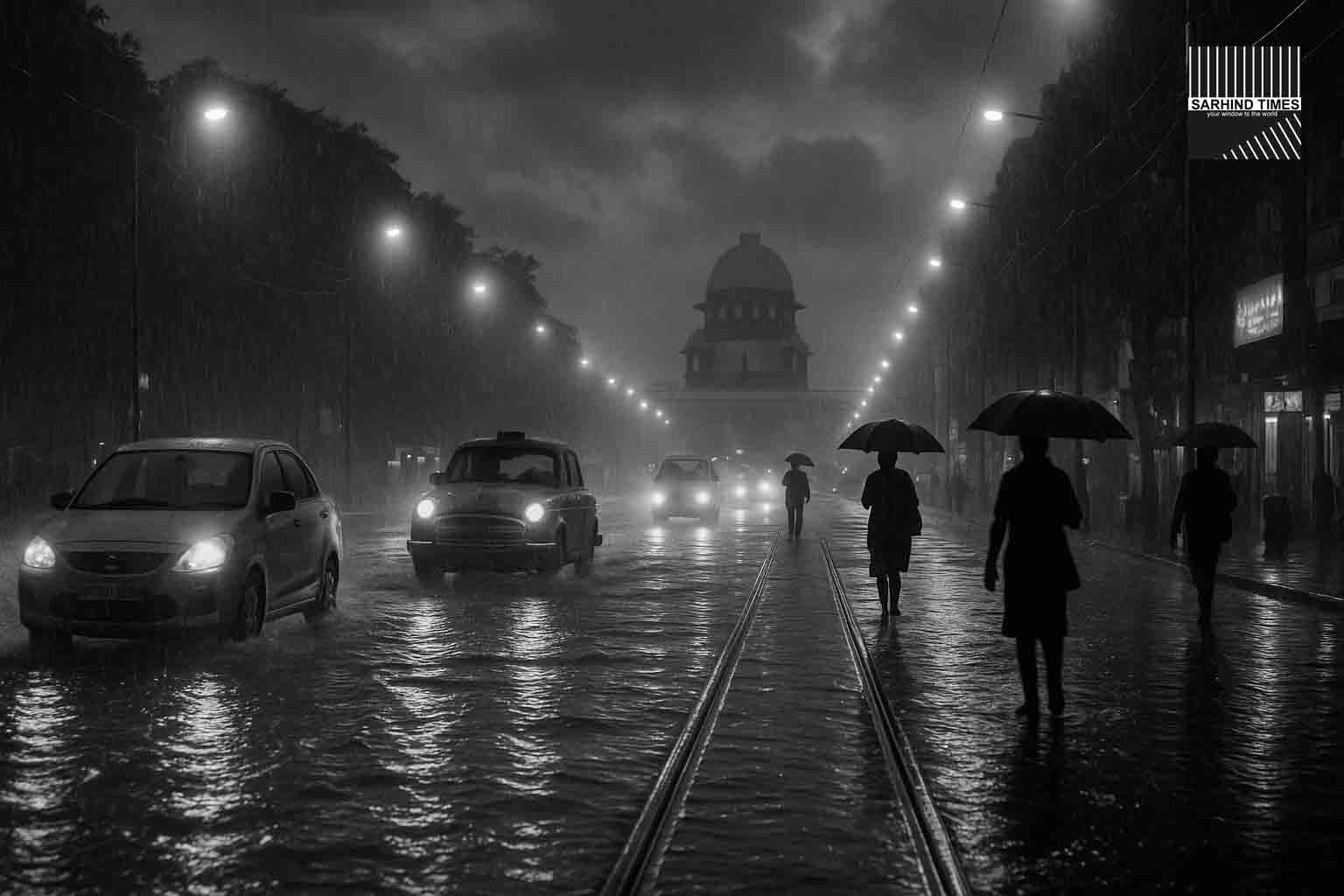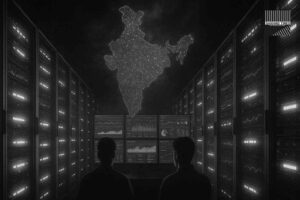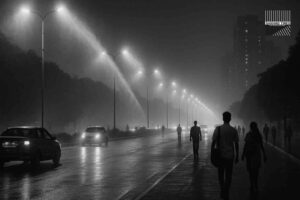Heavy afternoon rain drenched Kolkata and adjoining areas on Friday, causing waterlogging, traffic chaos, and a renewed call for better urban drainage ahead of festive crowds. The IMD has kept yellow alerts in place for multiple districts through October 11.
Kolkata | October 11, 2025
Kolkata woke up to a cloudy Friday but few expected the sky to open up with such intensity by afternoon. By 3 p.m., heavy showers accompanied by rumbling thunder rolled over the city, turning streets into shallow streams, halting traffic, and reminding residents that the monsoon—though officially retreating elsewhere—still lingers stubbornly over Bengal.
The India Meteorological Department (IMD) confirmed that the sudden downpour was caused by localized convective activity combined with residual moisture from the Bay of Bengal. It issued yellow alerts for North 24 Parganas, South 24 Parganas, Purba Medinipur, and Paschim Medinipur, warning of possible thunderstorm activity and lightning through the weekend.
A City Under Water—Again
Within minutes of the rainfall, familiar choke points such as Central Avenue, Park Circus, Esplanade, and Behala were submerged in ankle-deep water. Vehicles crawled through traffic, exhaust pipes submerged, and buses diverted from low-lying routes.
Commuters heading home from offices in Salt Lake and New Town reported delays of over an hour as the rain reduced visibility and water seeped into underpasses. “We’ve seen this movie every year,” said Ranjan Das, a daily commuter. “One good shower and the entire system collapses.”
Pedestrians sought shelter under awnings and bus stops while street vendors hurriedly covered their carts. For many, it was an inconvenient prelude to the Durga Puja season, when Kolkata expects millions to take to the streets.
IMD’s Alert and Forecast
The IMD’s Alipore observatory recorded 65 mm of rainfall between 3 p.m. and 6 p.m. Friday, with thunderstorms continuing into the evening. Officials said the instability was triggered by moisture incursion from the Bay coupled with daytime heating over land.
“While the monsoon has withdrawn from much of northwest India, conditions remain favorable for isolated heavy rainfall in East India,” said Dr. G. K. Das, head of IMD Kolkata. “We’ve issued yellow alerts for parts of South Bengal, urging citizens to stay indoors during thunderstorm activity.”
The forecast warns of light to moderate rain across Gangetic West Bengal over the next 48 hours, along with gusty winds of 30–40 kmph in coastal areas. Fishermen have been advised to avoid venturing into the sea till the system weakens.
Urban Infrastructure Under Pressure
For Kolkata’s civic planners, Friday’s deluge was another reminder that the city’s drainage and stormwater infrastructure is creaking under pressure.
Despite ongoing desilting work by the Kolkata Municipal Corporation (KMC), several areas saw water stagnation lasting three to four hours. Pumps in Kalighat, Dhakuria, and Chetla ran continuously through the evening to clear low-lying pockets.
“We’re working with legacy drains laid over a century ago,” admitted a KMC engineer. “High-intensity rain like this overwhelms the system within minutes. Modernization is costly and logistically complex, but it’s unavoidable.”
Urban experts say micro-drain management—smaller feeder channels linking neighborhoods to primary outfalls—has received insufficient attention. “Large drains can’t function if smaller pipelines are choked with plastic waste,” noted Dr. Nilanjana Banerjee, an environmental planner at Jadavpur University.
Impact on Traffic and Public Transport
The sudden showers caused major disruptions on EM Bypass, AJC Bose Road, and Howrah Bridge approaches. Traffic police deployed additional personnel to manage snarls, while Metro services ran with minor delays due to crowding at stations.
Ride-sharing app prices surged 2x to 3x in some areas as demand spiked and roads clogged. At Sealdah, passengers waded through puddles to reach platforms. The Kolkata Tramways temporarily halted services on certain routes where tracks were submerged.
“Our control room received 160 calls in just two hours,” said a Kolkata Traffic Police official. “We’re used to waterlogging, but the intensity today caught us off guard.”
Cyclists and delivery riders bore the brunt, navigating slippery roads with visibility reduced to a blur of headlights and rain sheets.
Festive Season Worries
With Durga Puja barely days away, the timing of the showers has alarmed organizers. Pandal workers in Bagbazar and Deshapriya Park rushed to cover half-built structures with tarpaulin.
“If it rains like this next week, decorations worth lakhs could be damaged,” said Suvendu Ghosh, a puja committee member in north Kolkata. “We’re reinforcing frames and waterproofing the base with plastic sheets.”
KMC has promised to keep storm drains functional round-the-clock through the festive season. Extra pumps are being stationed near major puja clusters, and control rooms will operate on 24-hour shifts.
Lightning Hazard and Safety Advisory
Beyond flooding, the IMD has flagged lightning as a major hazard during convective storms. At least four incidents of minor injuries were reported Friday when lightning struck trees in suburban areas.
Citizens have been advised to:
- Stay indoors during thunder activity.
- Avoid sheltering under trees or near tall structures.
- Unplug electrical appliances during heavy lightning.
- Monitor IMD’s “Nowcast” alerts via mobile apps.
“Even a brief lightning strike can be fatal if precautions are ignored,” warned Dr. Das. “We urge people not to take selfies or videos outdoors during storms.”
Monsoon Withdrawal—Not Quite Done Yet
Meteorologists note that while the monsoon withdrawal line has advanced through central India, eastern states remain moist due to persistent sea-surface temperature anomalies in the Bay of Bengal.
“This year’s withdrawal is one of the slowest in recent memory,” said weather scientist Abhijit Roy. “Localized convective bursts like Kolkata’s are typical during transition periods, when moisture pockets linger even as upper-air circulation weakens.”
Satellite data indicates that sporadic showers could continue until mid-October before a complete retreat.
Environmental Concerns: Drainage Meets Ecology
Environmental groups argue that Kolkata’s drainage crisis is also linked to vanishing wetlands that once acted as natural sponges. The East Kolkata Wetlands, a Ramsar site and the city’s biological waste-treatment zone, has been shrinking due to illegal construction.
“Wetlands absorb storm runoff. When they disappear, water has nowhere to go,” explained Prof. S. Bandyopadhyay of the Indian Institute of Social Welfare and Business Management. “Urban expansion without ecological balance invites chronic flooding.”
Activists have urged the state government to strengthen enforcement of wetland protection laws and accelerate eco-restoration efforts.
Public Voices: Fatigue and Frustration
Across social media, residents vented frustration under hashtags #KolkataRains and #WaterloggedCity. Photos showed vehicles half-submerged near Gariahat and children splashing through school compounds.
“Same story every year—rain comes, city stops,” wrote one user.
“Can we please get drains that work before flyovers that don’t?” posted another.
Yet, amid the chaos, there were flashes of Kolkata’s trademark resilience: commuters sharing umbrellas, traffic cops directing vehicles ankle-deep in water, and tea stalls doing brisk business under makeshift tarps.
Civic Response and Coordination
The Disaster Management Department coordinated with KMC, the Fire Brigade, and the West Bengal State Electricity Distribution Company (WBSEDCL) to manage outages and rescue calls.
Over 45 pumps were deployed in low-lying zones. The Kolkata Police Disaster Management Group cleared fallen branches from Ballygunge and Lake Town, while the fire department handled short-circuit incidents in Howrah.
“No major casualties have been reported,” said Mayor Firhad Hakim in a late-evening briefing. “We’re monitoring the situation continuously and have standby teams in every borough.”
Farmers Welcome the Rain
While the city struggled, the rain brought relief to farmers in adjoining districts. In Purba Medinipur and South 24 Parganas, paddy growers said the showers revived soil moisture before the winter crop cycle.
“It’s perfect timing for the aman harvest,” said Sukhen Pramanik, a farmer from Nandigram. “Too much rain would harm, but this balance is good.”
Agriculture officials confirmed that irrigation demand has eased, though they remain watchful of possible flooding in low-lying fields.
Historical Context: A Recurring Urban Lesson
Kolkata’s tryst with monsoon flooding is not new. Records show major waterlogging events in 1959, 1999, 2007, 2021, and 2023, each prompting promises of drainage overhaul.
Decades later, only partial solutions exist. Experts say climate change has increased short-duration, high-intensity rainfall, overwhelming colonial-era drainage lines.
The Kolkata Drainage Master Plan, drafted in 2018, envisaged a ₹4,500-crore revamp with smart pumping stations and GIS-based flood mapping—but progress remains slow.
“Our drainage planning still assumes yesterday’s rain, not tomorrow’s,” said Prof. Banerjee. “Without climate-adaptive design, we’ll keep reliving the same scenes every monsoon.”
Festive Readiness: The Countdown Begins
Despite the disruptions, the city is gearing up for Durga Puja, which begins next week. Municipal workers are racing against time to repair roads, repaint medians, and clear debris.
Electricians are inspecting pandal wiring to prevent short circuits, while health officers plan anti-mosquito drives post-rain.
Civic authorities promised that all major pumping stations will remain manned 24×7 through the festival period, with mobile units stationed near key intersections.
Meteorological Outlook Ahead
According to IMD’s five-day outlook, Kolkata and nearby districts may experience:
- Light to moderate rain till Sunday.
- Isolated heavy showers in coastal belts.
- Gradual improvement from Monday onward.
Temperature is expected to hover between 24°C and 31°C, with humidity levels above 85%.
Skies may remain partly cloudy during daytime, offering occasional sunshine between spells of drizzle—typical of a late monsoon fadeout.
Authorities Urge Vigilance
Officials reiterated that even brief spells of intense rain could lead to localized flooding due to tidal synchronization with the Hooghly River.
“When high tide coincides with heavy rain, discharge slows dramatically,” explained engineer Anirban Dutta from KMC’s drainage division. “Residents in low-lying neighborhoods like Topsia and Ekbalpore should stay alert.”
Citizens are encouraged to track live updates on the IMD website, Kolkata Police social handles, and Smart KMC app, which now provides ward-wise alerts and drainage updates.
A Broader Climate Message
Meteorologists emphasize that Kolkata’s recurring monsoon woes reflect a global pattern of urban climate stress. Rising sea levels, unpredictable rain patterns, and heat-island effects compound flood risk in deltaic cities worldwide.
“From Mumbai to Manila, coastal cities are fighting the same battle,” said climate scientist Dr. Swati Rao. “Kolkata’s challenge is local in scale but global in context.”
She noted that integrating climate resilience into urban planning—green roofs, permeable pavements, restored wetlands—can reduce flood intensity and heat impact simultaneously.
Conclusion: Rain, Reflection, and Resilience
As the showers tapered off by late evening, Kolkata’s skyline glistened with wet reflections under streetlights. Vendors reopened stalls, taxis resumed honking, and the city—true to its spirit—kept moving.
But the puddles on every corner are more than just water; they mirror the city’s unfinished task—modernizing its infrastructure to keep pace with its people.
In the days ahead, as festive lights shimmer and crowds return, Kolkata will hope that its resilience once again outshines its recurring monsoon woes.
Until then, umbrellas remain the city’s most reliable civic tool.
#Kolkata #IMD #Weather #Rain #Thunderstorms #Bengal #Monsoon #ClimateChange #UrbanFlooding #CityNews #SarhindTimes






















+ There are no comments
Add yours